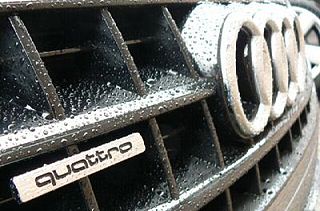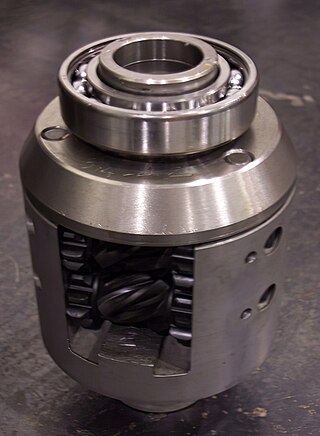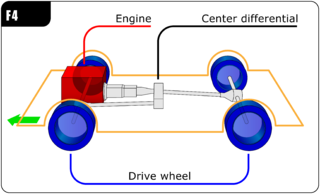
The Nissan Skyline GT-R is a Japanese sports car based on the Nissan Skyline range. The first cars named "Skyline GT-R" were produced between 1969 and 1972 under the model code KPGC10, and were successful in Japanese touring car racing events. This model was followed by a brief production run of second-generation cars, under model code KPGC110, in 1973.

A four-wheel drive, also called 4×4 or 4WD, is a two-axled vehicle drivetrain capable of providing torque to all of its wheels simultaneously. It may be full-time or on-demand, and is typically linked via a transfer case providing an additional output drive shaft and, in many instances, additional gear ranges.

Quattro is the trademark used by the automotive brand Audi to indicate that all-wheel drive (AWD) technologies or systems are used on specific models of its automobiles.

A transfer case is an intermediate gearbox that transfers power from the transmission of a motor vehicle to the driven axles of four-wheel-drive, all-wheel-drive, and other multi-axled on- and off-road machines. A part of the vehicle's drivetrain, it employs drive shafts to mechanically deliver motive power. The transfer case also synchronizes the difference between the rotation of the front and rear wheels, and may contain one or more sets of low range gears for off-road use.

A transaxle is a single mechanical device which combines the functions of an automobile's transmission, axle, and differential into one integrated assembly. It can be produced in both manual and automatic versions.

The Nissan Skyline is a brand of automobile originally produced by the Prince Motor Company starting in 1957, and then by Nissan after the two companies merged in 1967. After the merger, the Skyline and its larger counterpart, the Nissan Gloria, were sold in Japan at dealership sales channels called Nissan Prince Shop.

A drive shaft, driveshaft, driving shaft, tailshaft, propeller shaft, or Cardan shaft is a component for transmitting mechanical power, torque, and rotation, usually used to connect other components of a drivetrain that cannot be connected directly because of distance or the need to allow for relative movement between them.

Torsen Torque-Sensing is a type of limited-slip differential used in automobiles.

The Nissan Stagea, pronounced as "stage-A", is a station wagon produced by Nissan from 1996 to 2007. It was originally produced by Nissan in 1996 as direct competition for the Subaru Legacy Touring wagon in Japan, and was exclusive to Nissan Prince Store Japanese dealerships. The Stagea shares many mechanical parts with the Nissan Skyline and Nissan Laurel.

The Nissan Cima is a luxury sedan manufactured and marketed by Nissan for the Japanese market. The name Cima is derived from Spanish for "summit". Earlier generations featured a hood ornament with an image of an acanthus leaf that was the naming basis for the Nissan Laurel. The acanthus leaf was commonly used by classical Greeks to make a wreath for use as a crown.

The Infiniti QX70, formerly called the Infiniti FX until 2013, is a compact luxury crossover SUV produced by the Nissan-owned Infiniti luxury vehicle brand between 2002 and 2017. The FX replaced the QX4 as Infiniti's mid-size SUV. It shares the same FM platform as the rear-wheel drive Nissan 370Z, and it "made no claims of climbing mountains." Rather, its aggressive shape promised style and quick handling. The similarly sized Nissan Murano is based on the same D platform as the front-wheel drive Nissan Altima. The FX does not have a Nissan-branded equivalent and is not sold in Japan.
HICAS is Nissan's rear wheel steering system which was fitted to cars from approximately 1985 to 2010, including models ranging from the Skyline and Fairlady Z (Z32) to smaller vehicles like the Nissan Cefiro (A31), Silvia /240SX/180SX and Nissan Serena/Nissan Largo. It is also found on models from the Infiniti division, such as the Q45, J30, M45/M35 and G35/G37.
Torque steer is the unintended influence of engine torque on the steering, especially in front-wheel-drive vehicles. For example, during heavy acceleration, the steering may pull to one side, which may be disturbing to the driver. The effect is manifested either as a tugging sensation in the steering wheel, or a veering of the vehicle from the intended path. Torque steer is directly related to differences in the forces in the contact patches of the left and right drive wheels. The effect becomes more evident when high torques are applied to the drive wheels because of a high overall reduction ratio between the engine and wheels, high engine torque, or some combination of the two. Torque steer is distinct from steering kickback.

The Infiniti G Line is a series of compact executive cars manufactured and marketed by Infiniti, a luxury division of Nissan, for the 1991–1996 and 1999–2016 model years — across four generations.
Super Handling-All Wheel Drive (SH-AWD) is a full-time, fully automatic, all-wheel drive traction and handling system, which combines front-rear torque distribution control with independently regulated torque distribution to the left and right rear wheels. This way the system freely distributes the optimum amount of torque to all four wheels according to the driving conditions. The system was announced in April 2004, and was introduced in the North American market in the second generation 2005 model year Acura RL, and in Japan as the fourth generation Honda Legend.

All-Trac was a proprietary full-time four-wheel drive system used on a variety of Toyota badged models and the nameplate was used from 1988 to 2000. It was considered a revolutionary advance for four wheel drive automobiles into the mainstream consumer market and its electronic/vacuum controlled locking center differential was rare in a passenger car. The system originated in Japan under the GT-Four name in 1986, but was not released in the U.S. until 1988 under the All-Trac name.

The Nissan GT-R is a car built by Japanese marque Nissan since 2007. It has a 2+2 seating layout and is considered both a sports car and a grand tourer. The engine is front-mid mounted and drives all four wheels. It succeeds the Nissan Skyline GT-R, a faster variant of the Nissan Skyline. Although this model was the sixth-generation to bear the GT-R name, it is no longer part of the Skyline line-up. The car is built on the PM platform, derived from the FM platform used in the Skyline and Nissan Z models. Production is conducted in a shared production line at Nissan's Tochigi plant in Japan.

In automotive design, an F4, or front-engine, four-wheel drive (4WD) layout places the internal combustion engine at the front of the vehicle and drives all four roadwheels. This layout is typically chosen for better control on many surfaces, and is an important part of rally racing, as well as off-road driving. In terms of racing purposes, whether it be on-road or off-road, can be described as follows,
A team that pursues the Weak LS4WD architecture will minimize the development cost of the front-wheel drive system at the expense of having a larger rear powertrain. The Weak architecture produces a vehicle with a large powersplit between the front and rear powertrains, while the Strong architecture recommends a vehicle with more similar power and torque requirements for the front and rear.

The Infiniti QX50, marketed also until 2013 as the Infiniti EX and Nissan Skyline Crossover, is a front- or all-wheel drive, five passenger, five-door compact luxury crossover SUV, manufactured and marketed by Infiniti, Nissan's luxury division over three generations: one generation as the EX followed by two QX50 generations.

The Symmetrical All-Wheel Drive is a full-time four-wheel drive system developed by the Japanese automobile manufacturer Subaru. The system consists of a longitudinally mounted boxer engine coupled to a symmetrical drivetrain with equal length half-axles. The combination of the symmetrical layout with a flat engine and a transmission balanced over the front axle provides optimum weight distribution with low center of gravity, improving the steering characteristics of the vehicle. Ever since 1986, most of the Subaru models sold in the international market are equipped with the SAWD system by default, with the rear wheel drive BRZ and kei cars as the exceptions.
















